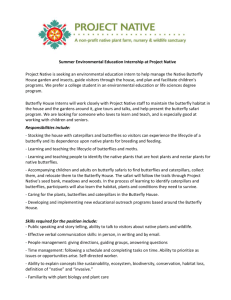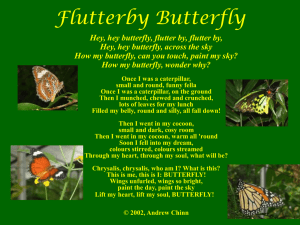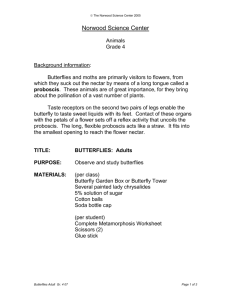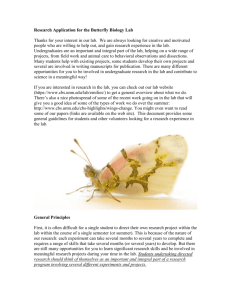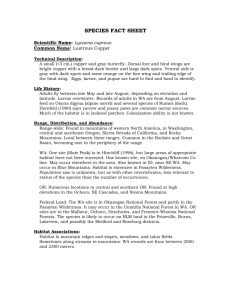November Book of the Month
advertisement
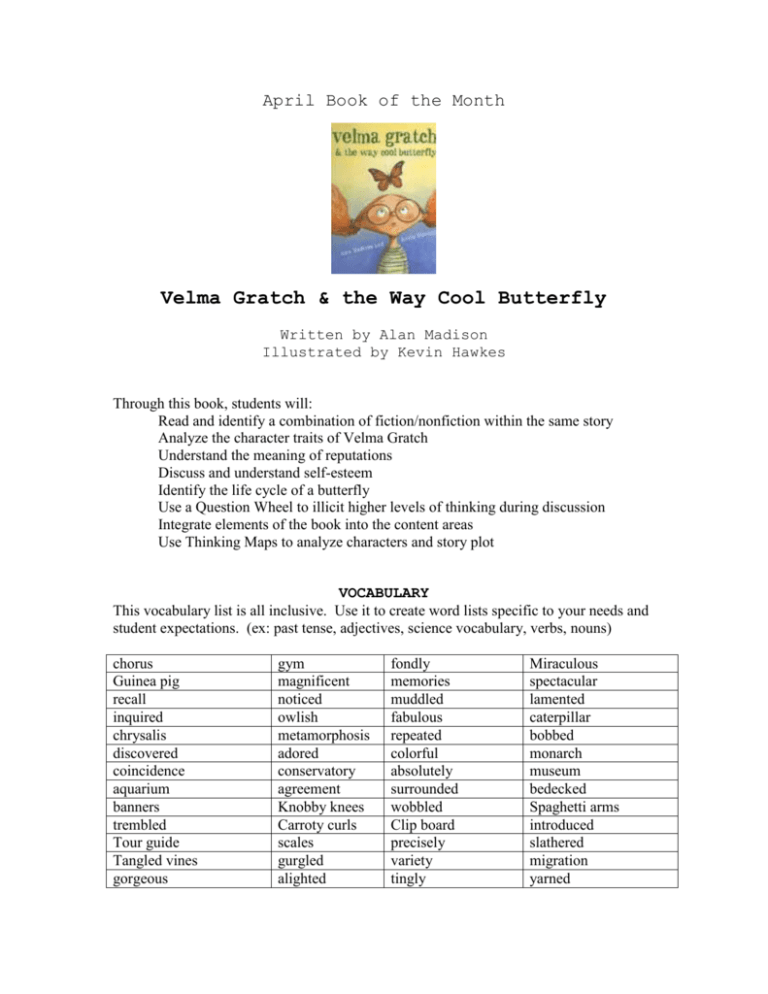
April Book of the Month Velma Gratch & the Way Cool Butterfly Written by Alan Madison Illustrated by Kevin Hawkes Through this book, students will: Read and identify a combination of fiction/nonfiction within the same story Analyze the character traits of Velma Gratch Understand the meaning of reputations Discuss and understand self-esteem Identify the life cycle of a butterfly Use a Question Wheel to illicit higher levels of thinking during discussion Integrate elements of the book into the content areas Use Thinking Maps to analyze characters and story plot VOCABULARY This vocabulary list is all inclusive. Use it to create word lists specific to your needs and student expectations. (ex: past tense, adjectives, science vocabulary, verbs, nouns) chorus Guinea pig recall inquired chrysalis discovered coincidence aquarium banners trembled Tour guide Tangled vines gorgeous gym magnificent noticed owlish metamorphosis adored conservatory agreement Knobby knees Carroty curls scales gurgled alighted fondly memories muddled fabulous repeated colorful absolutely surrounded wobbled Clip board precisely variety tingly Miraculous spectacular lamented caterpillar bobbed monarch museum bedecked Spaghetti arms introduced slathered migration yarned velvety antennae insect pointer commotion soaring “way cool” Brown Elfin Question Mark Gossemer Wing Pygmy Blue marvelous twitching whispered positively enormous overflowed Names of Butterflies: Frosted Sleepy Orange Flasher American Morpho Snout Orange Giant Monarch Swallowtail Black Monarch delicate wonderous perched fumed trailed floated Comma Painted Lady Short Tailed Skipper GENRE A Combination of Fiction and Non-Fiction LITERARY roosted weightless budge oversize flitted skyscrapers ELEMENTS Characterization Conflict LANGUAGE ARTS Writing Activities: Write From The Beginning: Use the theme of Informational Writing to have students each choose a different type of butterfly and to research their choice and illustrate their butterfly. (The book mentions about 10 different ones and that there are 20,000 different kinds. Write From The Beginning: Use the theme of Expository Writing: How to Care for a butterfly cocoon. Write From The Beginning: Use the theme of Imaginative Narrative: The Day A Butterfly Landed On My Finger. Great opportunity to do a mini-lesson on adjectives using the page with the door to the Butterfly Conservatory. Use the photos in the book to work with students on descriptive language and adjectives that describe Velma Gratch. Anchor charts of these descriptions will be helpful for students’ writing activities. Point out the way in which the words are written on the copyright page in the shape of a butterfly. Discuss why it is sometimes hard to follow in a sibling’s footsteps. ALLITERATION: (miraculous math, spectacular spelling, magnificent memories) ENVY: notice and discuss the looks on the other students’ faces on the page where they are all on the return bus trip. Would it be realistic for the butterfly to stay on her finger through the night, through gym class, through ballet and soccer, etc? Compare the caterpillars on the inside front cover to the butterflies on the inside back cover. Make words using only the letters from one word: METAMORPHOSIS, CONSERVATORY, etc. Draw your own butterfly and write about a trip you may want to take with it Have students keep a diary about the butterfly they will have in their classroom Sequencing Handout from hard copy lessons The Biggest Butterfly (student book made from handout template) Thinking Maps Create a flow map that charts the main events in the story. You can also do a flow map that charts the steps in the life cycle of a butterfly. Use a bubble map to describe Velma Gratch or to describe butterflies. Use a tree map to categorize information from the book, such as: Metamorphosis Cocoon Caterpiller Butterfly Use a double bubble map to compare Velma Gratch to her sister Frieda. Use another double bubble map to compare Velma Gratch to her sister Fiona. Also compare and contrast the butterfly’s trip to Mexico to her family’s trip to Mexico. Create a multi-flow map to describe cause and effect based on what happens in the story and why. MATH Count all the different butterflies represented in the book “Pasta-bilities” from the hardcopy handout Measure a variety of butterflies using centimeters and inches Caterpillar Butterfly Math lesson from hardcopy handout Take classroom polls and create graphs to show the results: How many brother and sisters do you have? How many of you are the youngest of all your siblings? Show several butterflies: which one is your favorite? Science The Life cycle of butterflies MIGRATION: Study and learn about METAMORPHOSIS Habitats – Find out why the students must not touch the butterflies. Recognize the importance of living things and what purpose they have in their growth, survival, and reproduction Living and non-living organisms Create a butterfly garden Lots of science activities in your hard copy handout FINE ARTS Do a class project on STUDENT METAMORPHOSIS. Have students bring in a picture of themselves as babies and one of themselves now. Then have them draw how they think they will look as a young adult and then as an elderly person. Use these pictures and illustrations to create a chart of the Life Cycle of (student). Draw different shapes of butterflies Make a butterfly mobile (hardcopy handout) Egg Carton Butterfly (hard copy handout) Sun-Catcher Butterfly (hard copy handout) Websites: www.kevinhawkes.com www.justonemorebook.com2007/11/12/interview-with-kevin-hawkes www.randomhouse.com/catalog/teachers guides/9780375835971.pdf




